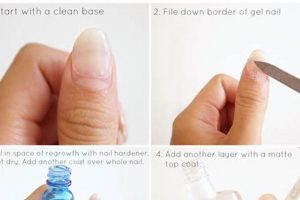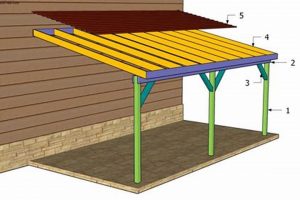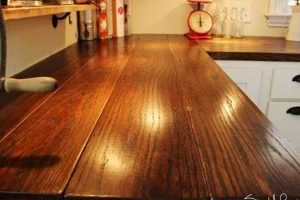Constructing protective and decorative casings for books using personal resources and techniques allows for customization and preservation. These projects range from simple paper wraps to more elaborate fabric or repurposed material designs. An example includes using decorative paper and adhesive to create a custom-fitted jacket for a paperback novel, providing both protection and a unique aesthetic.
The practice offers a cost-effective method of safeguarding books from wear and tear, extending their lifespan. Furthermore, it provides an opportunity for creative expression, enabling individuals to personalize their reading materials and reflect their individual style. Historically, book protection has evolved from simple binding methods to elaborate artistic endeavors, and this modern iteration continues that tradition with an emphasis on accessibility and personal touch.
The following discussion will delve into the various materials, techniques, and design considerations involved in creating customized book casings, addressing practical applications and inspiring creative exploration. This comprehensive overview aims to equip individuals with the knowledge necessary to embark on their own personalized book protection projects.
DIY Book Covers
Creating durable and visually appealing book covers requires careful planning and execution. The following tips provide practical advice for achieving professional-looking results.
Tip 1: Precise Measurement is Essential. Accurate dimensions of the book are crucial before beginning any cover project. Measure the height, width, and spine thickness, adding extra allowance for folding and overlap. Incorrect measurements can lead to ill-fitting and ineffective protection.
Tip 2: Material Selection Impacts Longevity. The chosen material significantly affects the cover’s durability and aesthetic appeal. Consider factors such as thickness, texture, and resistance to wear and tear. For example, heavy-duty cardstock provides greater protection than standard printer paper.
Tip 3: Adhesives Should Be Archival Quality. Using acid-free adhesives is critical to prevent damage to the book over time. Acidic adhesives can cause discoloration and degradation of the book’s original cover and pages. Look for adhesives specifically labeled as archival or acid-free.
Tip 4: Reinforce Stress Points for Durability. Areas subject to frequent handling, such as the spine and corners, should be reinforced. Consider using bookbinding tape or additional layers of material to strengthen these vulnerable points.
Tip 5: Consider Protective Laminates or Coatings. Applying a laminate or protective coating can enhance the cover’s resistance to moisture, scratches, and fading. Options include self-adhesive laminating sheets or spray-on acrylic coatings.
Tip 6: Secure Flaps Enhance Functionality. Integrated flaps that wrap around the front and back covers can provide added security and prevent the cover from slipping off. Ensure flaps are adequately sized to accommodate varying book thicknesses.
Tip 7: Decorative Embellishments Should Be Non-Abrasive. If incorporating decorative elements, such as beads or appliqus, ensure they are securely attached and do not scratch or damage surrounding surfaces. Consider the long-term impact of embellishments on the cover’s integrity.
These guidelines offer a foundation for creating book covers that effectively protect and enhance the books they encase. Implementing these techniques can significantly improve the longevity and visual appeal of homemade covers.
Moving forward, the article will explore various design styles and artistic approaches for creating customized book covers, catering to a range of personal preferences and skill levels.
1. Protection
Protection constitutes a fundamental imperative in the realm of book ownership, directly influencing the longevity and condition of textual resources. The integration of protective measures into the construction of personalized book casings serves as a preventative safeguard against various detrimental environmental factors. These factors include, but are not limited to, physical abrasion, moisture exposure, ultraviolet radiation, and the accumulation of particulate matter. Failure to implement adequate protective measures can result in irreversible damage, leading to the degradation of covers, warping of pages, and fading of inks. As an illustrative example, a textbook frequently transported within a backpack is susceptible to significant wear and tear. A well-constructed casing, utilizing durable materials, can mitigate this risk, preserving the book’s structural integrity and legibility.
The degree of protection afforded by a customized casing is directly proportional to the materials employed and the construction techniques implemented. Robust materials such as heavy-grade cardstock, reinforced fabric, or treated leather offer superior resistance to physical damage compared to more delicate alternatives. Similarly, the application of protective coatings, such as laminates or water-resistant sprays, can enhance the cover’s resilience against spills and moisture-related damage. The effective design incorporates reinforced corners and spine, which are particularly vulnerable areas. Furthermore, attention to detail in the sealing of edges can prevent the ingress of dust and other contaminants.
In summary, the proactive integration of protective elements within do-it-yourself book casings is paramount for ensuring the long-term preservation of valuable textual assets. A thorough understanding of the potential environmental threats and the appropriate mitigation strategies, coupled with careful material selection and construction techniques, yields a protective barrier that significantly extends the lifespan and maintains the aesthetic quality of encased books. The understanding and implementation of protection are thus critical components to consider when choosing to create a DIY book cover.
2. Customization
Customization, in the context of personal book casing, represents the ability to tailor the appearance and functionality of a book cover to specific aesthetic preferences, functional requirements, and personal identities. It moves beyond mere protection to become an extension of the reader’s individual expression.
- Material Selection
The choice of materialsranging from repurposed textiles and decorative papers to more durable fabrics and treated leatherdirectly impacts the aesthetic and tactile qualities of the finished product. This selection allows for the incorporation of personal meaning through the use of sentimental fabrics or preferred textures, directly reflecting individual style.
- Design and Imagery
Custom book casing enables the incorporation of unique designs, patterns, and imagery. This can range from hand-painted artwork and digitally printe
d graphics to collage elements and personalized monograms. The integration of such elements transforms a functional object into a personalized work of art, representative of the owner’s tastes and interests. - Functional Modifications
Personalization extends to functional enhancements, such as the inclusion of pockets for storing bookmarks, integrated pen loops, or adjustable closures to accommodate varying book thicknesses. These modifications enhance the usability and practicality of the casing, tailored to specific needs.
- Thematic Representation
Personalized book casing provides an opportunity to visually represent the content or themes contained within the book. Covers can be designed to reflect the genre, subject matter, or a personal interpretation of the narrative, creating a visual connection between the exterior and interior of the book.
The integration of these facets underscores the intrinsic value of personalized book casing as a means of expressing individuality and enhancing the overall reading experience. By combining functional protection with bespoke design elements, customized book casings transform a utilitarian item into a personalized artifact.
3. Affordability
The economic advantage presented by the creation of personalized book protection represents a significant factor in the adoption of this practice. Avoiding commercially manufactured options can result in substantial cost savings, particularly for individuals with extensive libraries or those seeking to protect frequently used volumes. This economic consideration is especially pertinent in educational settings and for individuals with budget constraints.
- Material Sourcing
Cost-effectiveness is significantly influenced by the selection and procurement of materials. Utilizing recycled materials, such as repurposed cardboard, fabric scraps, or discarded maps, substantially reduces expenses compared to purchasing new materials. The strategic acquisition of materials through discounts, sales, or bulk purchases further optimizes budgetary efficiency. This practice allows for the creation of functional and aesthetically pleasing covers without incurring significant financial burden.
- Reduced Replacement Costs
Effective book protection minimizes the need for book replacements due to damage or wear. By investing time and effort in creating durable protective casings, individuals can extend the lifespan of their books, thereby avoiding the expense of repurchasing damaged or worn copies. This long-term cost reduction is particularly beneficial for students, educators, and avid readers who rely on a large collection of books.
- Skill-Based Labor
The primary investment in creating customized book protection is labor, not capital. Developing the skills necessary to design and construct effective covers eliminates reliance on external services or commercially produced alternatives. While initial attempts may require some experimentation and refinement, the long-term cost savings associated with self-sufficiency in book protection are considerable. Moreover, the acquired skills can be applied to other craft projects, further enhancing the value of this investment.
- Customization Value Proposition
The intersection of affordability and customization provides a unique value proposition. Individuals can create book protection that not only meets their functional needs but also reflects their personal style and preferences, all while remaining within a defined budget. This allows for an individualized product at a cost often lower than mass-produced, less customizable alternatives. The ability to control both the design and the expenditure contributes to the attractiveness of this practice.
In conclusion, the economic benefits associated with personal book protection extend beyond the immediate savings on cover materials. The long-term reduction in replacement costs, the efficient use of resources, and the personalized value derived from self-sufficiency contribute to a cost-effective and sustainable approach to book preservation. The intersection of affordability and customization creates a compelling argument for the widespread adoption of this practice.
4. Sustainability
The intersection of sustainable practices and personalized book casing yields significant environmental and resource management implications. Constructing protective covers from repurposed materials directly reduces the demand for newly manufactured goods, thus minimizing resource extraction, energy consumption, and waste generation associated with industrial production. Utilizing discarded textiles, reclaimed paper, and recycled cardboard diverts these materials from landfills, mitigating the detrimental effects of waste accumulation and decomposition, including greenhouse gas emissions and soil contamination.
The selection of environmentally conscious adhesives and inks further contributes to the sustainability of these projects. Opting for water-based, non-toxic adhesives and vegetable-based inks reduces the release of volatile organic compounds (VOCs) and other harmful chemicals into the environment. Furthermore, employing durable and long-lasting materials minimizes the frequency of replacement, thereby extending the lifespan of both the book and its protective casing. An example includes using old denim jeans to create robust covers, leveraging the fabric’s inherent durability and diverting textile waste from disposal. Similarly, utilizing paper grocery bags or newspapers for cover construction provides a practical and ecologically responsible alternative to purchasing new paper products.
In summation, incorporating sustainability into the design and creation of personalized book casings offers a tangible approach to environmental stewardship. By prioritizing the use of recycled materials, minimizing chemical inputs, and extending product lifecycles, individuals can contribute to a more circular economy and reduce their environmental footprint. The growing awareness of these sustainable practices within the crafting community underscores the increasing importance of responsible resource utilization and waste reduction in all aspects of creative endeavors. This heightened consciousness fosters a more ecologically sound approach to book preservation and personal expression.
5. Creativity
The creation of customized book protection inherently necessitates creative input. The process extends beyond mere replication or functional construction; it demands the application of imagination and innovative problem-solving. The limitations of commercially available options often stifle individual expression, whereas crafting unique covers allows for a personalized aesthetic that reflects the reader’s individual tastes, the book’s contents, or a combination thereof. For instance, a student might create a cover for a science textbook depicting microscopic imagery rendered in vibrant colors, transforming a potentially mundane object into a visually engaging piece.
The act of personalizing book casings promotes experimentation with diverse materials, textures, and techniques. From hand-painted
designs to digitally printed graphics, the creative possibilities are extensive. The integration of unexpected elements, such as embedded found objects or unconventional stitching patterns, transforms the cover into a tangible expression of artistic vision. The choice of colors, patterns, and embellishments can evoke specific moods, enhance the reading experience, or serve as a visual mnemonic device, aiding in the recall of key information within the book. Moreover, adapting to material constraints or design challenges fosters resourcefulness and ingenuity, further strengthening creative capabilities. An artist may use old newspapers as a base for the book covers, creating an unique appearance to show the age of the book or just for artistic design for the cover.
In essence, the relationship between creativity and personalized book casing is mutually reinforcing. The act of creating a customized cover stimulates imagination, encourages experimentation, and provides a tangible outlet for artistic expression. Conversely, a strong creative vision elevates a functional object into a unique artifact, adding aesthetic value and personal significance to the reading experience. The capacity to create uniquely styled book covers is therefore not merely a skill but a form of artistic expression with a very practical application.
6. Preservation
The inherent purpose of customized book casings extends significantly beyond aesthetic enhancement, functioning primarily as a protective barrier that actively contributes to the physical preservation of textual volumes. The implementation of appropriate protective measures is crucial for mitigating the detrimental effects of environmental factors and physical wear, thereby extending the lifespan of valuable literary resources.
- Mitigation of Physical Damage
Constructing protective casings from durable materials such as reinforced cardstock, fabric, or repurposed textiles provides a physical shield against abrasion, tears, and crushing forces. This protection is especially pertinent for frequently handled books or those subjected to potentially damaging storage conditions. For example, a textbook carried in a backpack experiences constant friction and impact; a well-constructed jacket mitigates these stressors, preventing damage to the cover and binding.
- Environmental Protection from Moisture and Light
Exposure to moisture and ultraviolet radiation accelerates the degradation of paper and binding materials. Implementing water-resistant coatings or utilizing UV-blocking fabrics in the construction of casings offers a degree of protection against these environmental factors. Storing books in direct sunlight leads to fading and discoloration; a protective cover minimizes this exposure, preserving the original appearance of the book.
- Dust and Particulate Matter Control
The accumulation of dust and particulate matter on book surfaces contributes to gradual wear and can attract pests that damage paper and binding. A tightly fitted casing serves as a barrier against these contaminants, reducing the need for frequent cleaning and minimizing the risk of infestation. In libraries or homes with high dust levels, this protective measure is crucial for maintaining the cleanliness and integrity of book collections.
- Extending Binding Integrity
The structural integrity of a book’s binding is critical for its long-term preservation. Protective casings can provide additional support to the spine, preventing loosening or separation of the pages. This is particularly beneficial for older or more fragile books with weakened bindings. A well-designed casing distributes stress along the spine, reducing the strain on individual binding elements and prolonging the book’s usability.
The multifaceted approach to preservation afforded by personalized book casings underscores their functional significance. By addressing a range of environmental and physical threats, these covers actively contribute to the long-term maintenance and accessibility of textual resources, ensuring their preservation for future generations. The emphasis on protective features in the design and construction of these casings elevates them beyond mere decorative accessories, transforming them into essential tools for safeguarding literary heritage.
Frequently Asked Questions
This section addresses common inquiries regarding the creation, application, and maintenance of personalized book casings, offering detailed explanations and practical guidance.
Question 1: What materials are best suited for creating durable book casings?
The selection of materials depends on the intended use and desired aesthetic. Heavy-duty cardstock, canvas fabric, and reinforced bookbinding cloth offer superior durability compared to standard paper. Repurposed materials, such as denim or vinyl, provide both sustainability and resilience. The choice should reflect the book’s size, weight, and anticipated handling frequency.
Question 2: How can accurate measurements be obtained for a snug and protective fit?
Precise measurements are essential. Measure the book’s height, width, and spine thickness using a ruler or measuring tape. Add an additional inch to each dimension to allow for folding and seam allowances. It is advisable to create a paper template based on these measurements before cutting the final material.
Question 3: What adhesive types are recommended to avoid damage to the underlying book cover?
Acid-free, archival-quality adhesives are imperative to prevent discoloration and degradation of the book’s original cover. Avoid using solvent-based glues or tapes, as these can leach chemicals that damage paper and binding. Bookbinding glue or pH-neutral adhesive tapes are suitable options.
Question 4: How can the spine of a casing be reinforced to prevent cracking or tearing?
Reinforcing the spine is crucial for longevity. Incorporate a strip of heavy-duty canvas or bookbinding tape along the spine during construction. This adds structural support and prevents wear along this high-stress area. Consider using multiple layers of material for added reinforcement.
Question 5: What techniques can be used to create a water-resistant finish on a book casing?
Applying a water-resistant coating can protect against spills and moisture. Laminating sheets or spray-on acrylic sealants can create a protective barrier. Ensure that the chosen sealant is compatible with the casing material to avoid discoloration or damage. Multiple thin coats are generally more effective than a single heavy coat.
Question 6: How can a book casing be securely attached to the book without damaging the original cover?
Avoid directly adhering the casing to the book’s original cover. Instead, utilize flaps that fold around the front and back covers, securing the casing in place. These flaps should be sized appropriately to accommodate the book’s thickness and prevent slippage. Alternatively, consider using elastic bands or ribbon ties to secure the casing without adhesive.
The creation of effective, personalized book protection requires careful planning, material selection, and execution. Adherence to these guidelines will ensure both the aesthetic appeal and the long-term preservation of encased books.
The subsequent section will explore advanced techniques for designing and constructing intricate book casings, catering to experienced crafters and enthusiasts seeki
ng to refine their skills.
DIY Book Covers
This exploration of DIY book covers has illuminated their multifaceted nature, extending beyond mere functional protection. The practice encompasses resourcefulness, sustainability, creative expression, and economic efficiency, resulting in a unique synergy that benefits both the individual and the environment. From material selection to design implementation, the process allows for personalized adaptation and preservation of literary resources.
The continued relevance of DIY book covers resides in their capacity to empower individuals to actively participate in the lifecycle of their possessions. By embracing this practice, one contributes to a more sustainable approach to resource management and fosters a deeper appreciation for the value of both creativity and literature. The emphasis on durability and aesthetic appeal elevates the process from a simple task to an enduring form of functional art, thus ensuring its continued significance in a world increasingly focused on personalization and sustainability.


![Diya Aur Baati Hum: Illuminate Your Home [DIY Guide] The DIY Hub: Creative Crafts, Repairs & Life Hacks Diya Aur Baati Hum: Illuminate Your Home [DIY Guide] | The DIY Hub: Creative Crafts, Repairs & Life Hacks](https://craftingdiycenter.com/wp-content/uploads/2025/07/th-5913-300x200.jpg)




